Taxonomy: Class: Mammalia; Order: Insectivora; Family: Erinaceidae
Description
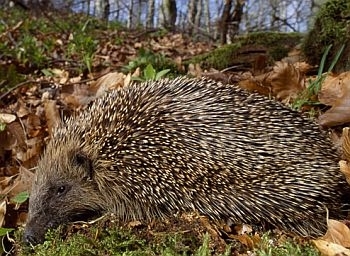
Hedgehog © Laurie Campbell
The hedgehog is a small insectivorous mammal covered with sharp defensive spines. It is almost entirely nocturnal, and feeds on ground-dwelling invetebrates including slugs and snails. It also eats the eggs and chicks of ground-nesting birds, sometimes to devastating effect (Jackson & Green 2000). It likes a varied habitat, and often visits suburban gardens (Sedgly 1991).
The hedgehog benefits from partial protection under the Wildlife & Countryside Act (1981). The numbers reported to the NGC nowadays have been caught unintentionally in tunnel traps set for rats or small mustelids.
In 2021, the People's Trust for Endangered Species commissioned a report on the trends and distribution of hedgehogs reported to the NGC from 1981 to 2019, for inclusion in its State of Britain’s Hedgehogs assessment. The NGC report is available for download here.
Further information:
Mammal Society website hedgehog page.
Conservation status and legislation
Status:
UK: Native. Priority species under the UK Biodoversity Action Plan
World: Least Concern (IUCN Red List)
Legislation:
Distribution and abundance
The hedgehog is widespread across the the whole of Britain. It has been introduced to many of its offshore islands as well as to the Isle of Man and the Channel Islands. It is found throughout Ireland, although a scarcity of records means that this is not apparent from the map.
Estimates of hedgehog abundance (numbers of individuals in the spring) across the UK, from Harris et al. (1995):
Recent trends from the National Gamebag Census
United Kingdom
Index of bag density from 1961 to 2009 (see statistical methods and interpretational considerations).
Error bars represent 95% confidence intervals.
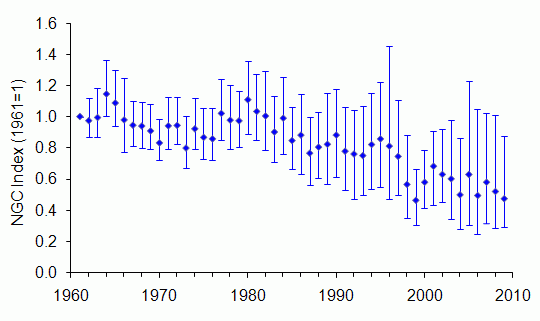
After remaining approximately level for 20 years, the bag index declined from 1980 to 2009, leading to an overall significant decline since 1961. The decline coincides with the rise of the badger, an important predator of hedgehogs, which has been shown to limit hedgehog distribution (Doncaster 1994). However, a similar decline could also arise through a reduction in trapping effort over time.
Change in hedgehog bags over time, with 95% confidence limits (see statistical methods):
| Country |
Sites |
Start
year |
End
year |
Change (%)
1961-2009 |
Change (%)
1984-2009 |
Change (%)
1995-2009 |
| United Kingdom |
697 |
1961 |
2009 |
-52*
-74 to -9 |
-46
-68 to 2 |
-33
-54 to 2 |
* significant at P < 0.05
England
Index of bag density from 1961 to 2009 (see statistical methods and interpretational considerations).
Error bars represent 95% confidence intervals.
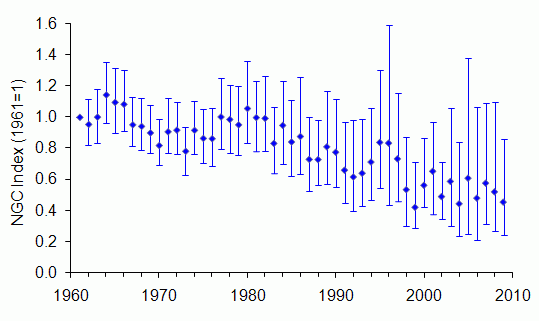
After remaining approximately level for 20 years, the bag index appeared to decline from 1980 to 2009 as it did for the UK. However, the change is not statistically significant. The apparent decline coincides with the rise of the badger, an important predator of hedgehogs, which has been shown to limit hedgehog distribution (Doncaster 1994). However, a similar decline could also arise through a reduction in trapping effort over time.
Change in hedgehog bags over time, with 95% confidence limits (see statistical methods):
| Country |
Sites |
Start
year |
End
year |
Change (%)
1961-2009 |
Change (%)
1984-2009 |
Change (%)
1995-2009 |
| England |
546 |
1961 |
2009 |
-53
-78 to 2 |
-45
-71 to 13 |
-28
-56 to 12 |
* significant at P < 0.05
Scotland
Index of bag density from 1961 to 2009 (see statistical methods and interpretational considerations).
Error bars represent 95% confidence intervals.
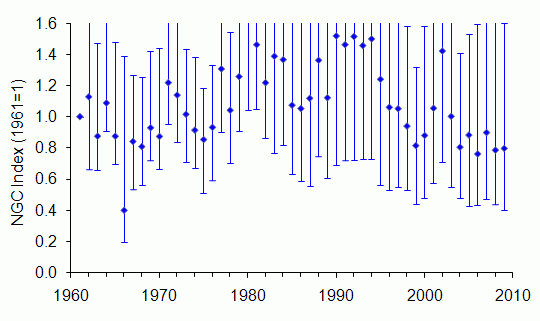
Although no trend was detected overall, there has been a significant decline in the bag index between 1984 and 2009. The decline coincides with the rise of the badger, an important predator of hedgehogs, which has been shown to limit hedgehog distribution (Doncaster 1994). However, a similar decline could also arise through a reduction in trapping effort over time.
Change in hedgehog bags over time, with 95% confidence limits (see statistical methods):
| Country |
Sites |
Start
year |
End
year |
Change (%)
1961-2009 |
Change (%)
1984-2009 |
Change (%)
1995-2009 |
| Scotland |
130 |
1961 |
2009 |
-19
-59 to 45 |
-40*
-62 to -4 |
-37
-62 to 18 |
* significant at P < 0.05
Wales
Index of bag density from 1961 to 2009 (see statistical methods and interpretational considerations).
Error bars represent 95% confidence intervals.
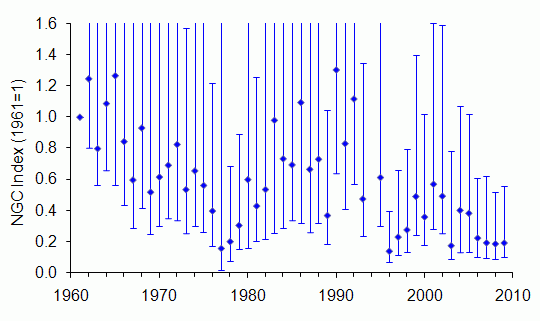
There has been a significant decline in the bag index between 1961 and 2009. The decline persists across the most recent 25-year and 15-year periods. The decline coincides with the rise of the badger, an important predator of hedgehogs, which has been shown to limit hedgehog distribution (Doncaster 1994). However, a similar decline could also arise through a reduction in trapping effort over time.
Change in hedgehog bags over time, with 95% confidence limits (see statistical methods):
| Country |
Sites |
Start
year |
End
year |
Change (%)
1961-2009 |
Change (%)
1984-2009 |
Change (%)
1995-2009 |
| Wales |
19 |
1961 |
2009 |
-84*
-90 to -78 |
-73*
-77 to -65 |
-68*
-71 to -63 |
* significant at P < 0.05
N Ireland
There are too few bag records of hedgehog to produce an index graph. 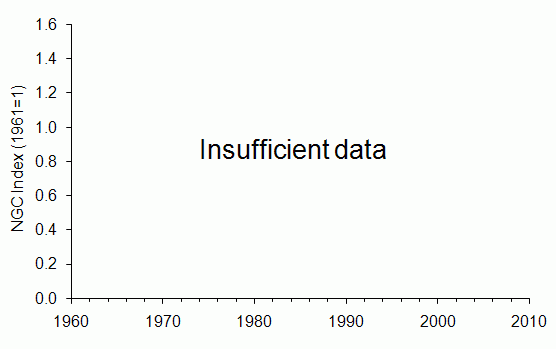
There are too few bag records of hedgehog to evaluate rates of change over time
| Country |
Sites |
Start
year |
End
year |
Change (%)
1961-2009 |
Change (%)
1984-2009 |
Change (%)
1995-2009 |
| N Ireland |
Too few sites |
Environmental zones
Change in hedgehog bags over time, with 95% confidence limits (see statistical methods):
| Environmental zone |
Sites |
Start
year |
End
year |
Change (%)
1961-2009 |
Change (%)
1984-2009 |
Change (%)
1995-2009 |
| Easterly lowlands (England/Wales) |
381 |
1961 |
2009 |
-51
-81 to 15 |
-40
-75 to 31 |
-28
-63 to 21 |
| Westerly lowlands (England/Wales) |
122 |
1961 |
2009 |
-70*
-86 to -11 |
-77
-76 to 18 |
96
-23 to 377 |
| Uplands (England/Wales) |
60 |
1961 |
2009 |
-48
-80 to 147 |
-51
-73 to 9 |
-40
-76 to 122 |
| Lowlands (Scotland) |
46 |
1961 |
2009 |
-35
-78 to 66 |
-62
-82 to 5 |
-63
-84 to 44 |
| Intermediate uplands/islands (Scotland) |
23 |
1961 |
2009 |
23
-32 to 161 |
-15
-54 to 93 |
15
-29 to 62 |
| True uplands (Scotland) |
60 |
1961 |
2009 |
-8
-56 to 77 |
-10
-48 to 45 |
29
-26 to 104 |
* significant at P < 0.05
Comparison with BBS mammal data
No comparison with the NGC trend is possible because too few hedgehog records are received through the Breeding Bird Survey (BBS) organised by the British Trust for Ornithology.
Long-term trend from the National Gamebag Census
There are too few bag records of hedgehog to produce a trend starting before 1961.
References and further reading
- Battersby,J. (2005). UK Mammals: Species Status and Population Trends. Joint Nature Conservation Committee/Tracking Mammals Partnership, Peterborough (JNCC download page).
- Doncaster,C.P. (1994). Factors regulating local variations in abundance: field tests on hedgehogs, Erinaceus europaeus. Oikos 69: 182-192.
- Harris,S., Morris,P., Wray,S. & Yalden,D.W. (1995). A Review of British Mammals: Population Estimates and Conservation Status of British Mammals Other than Cetaceans. Joint Nature Conservation Committee, Peterborough (JNCC download page).
- Harris,S. & Yalden,D.W. (2008). Mammals of the British Isles: Handbook, 4th edition. Mammal Society, Southampton.
- Jackson,D.B. & Green,R.E. (2000). The importance of the introduced hedgehog (Erinaceus europaeus) as a predator of the eggs of waders (Charadrii) on machair in South Uist, Scotland. Biological Conservation 93: 333-348.
- Morris,P. (2006). The New Hedgehog Book. Whittet Books, London.
- Sedgley,J. (1991). Hedgehogs in Your Garden? Mammal Society, Southampton.
This report should be cited as: Aebischer,N.J., Davey,P.D. & Kingdon,N.G. (2011). National Gamebag Census: Mammal Trends to 2009. Game & Wildlife Conservation Trust, Fordingbridge (http://www.gwct.org.uk/ngcmammals).
Return to species list